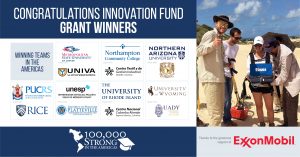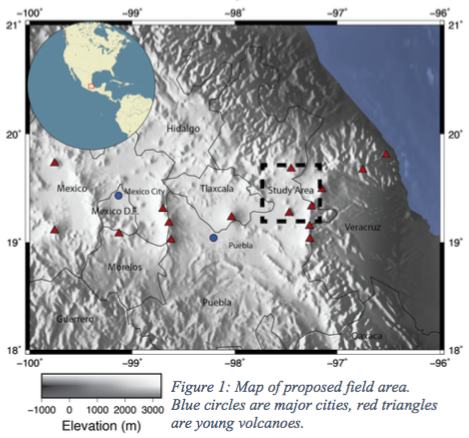Four geology students from Northern Arizona University will spend part of their summer in a volcanic field in central Mexico, paid for by a grant from the 100,000 Strong for the Americas program.
The geophysics course, which assistant geology professor Ryan Porter will lead with support from geology professor Michael Ort, will connect NAU and the Universidad Autónoma de México (UNAM), the largest university in Mexico. The NAU group will join four students and two professors from UNAM to do research in the Serdán-Oriental Volcanic Field in Puebla in east-central Mexico, studying the roots of young volcanoes to determine how magma connects, how the volcanoes formed, why the field formed where it did and more.
The questions they’re asking are the same questions Porter and other geologists have asked about the volcanic field north of Flagstaff, which has acted in much the same way through its lifetime.
“We don’t really understand why these magmas form, probably 40 to 60 kilometers down in the earth, how they make it through and interact with the crust or how those eruptions behaved in the subsurface,” he said. “The volcanoes in Mexico will be similar to those here in Flagstaff.”
The senior undergraduate and graduate students will get two weeks of videoconferenced lectures and discussions between the eight students, Porter, Ort and UNAM professors Gerardo Carrasco Nuñez and Fernando Corbo in preparation for the trip, which likely will take place in July.
Students will use geophysical techniques like seismic refraction, electromagnetics and magnetic surveys to study how the volcanoes formed, why they formed where they did and how they’re connected to each other. As the course continues, faculty members will decrease their involvement, ensuring the students become proficient in the skills and equipment.

After the research is done, half of the students—two from NAU and two from UNAM—will return to Flagstaff to analyze the data, while the other four students will remain in Mexico to analyze data there. All eight students then will contribute to the report, which will include a review of relevant literature in both Spanish and English.
Although the scientist in him has questions about volcanic fields and how to better understand their growth and activity, Porter said the main purpose of this grant and course is to provide a hands-on, multicultural educational experience for the students.
“The hope is they’ll learn how these geophysics techniques work and how to apply them,” Porter said.
He also hopes this course will provide a framework for other study-abroad geology courses. Geology students are less likely than their peers to study abroad in college, in part because the degree requirements make a semester away from NAU difficult. Courses such as this, that take place outside the normal school year and don’t require a full semester, may be one solution to that.
This course also is likely the first of many collaborations between the two universities; NAU and UNAM are in the process of signing an agreement to facilitate future student exchanges.
“We’re using this to jumpstart a longer-term exchange program with UNAM,” Ort said.
The grant, which is industry-funded, is the second NAU has received from 100,000 Strong in the Americas, which former President Barack Obama started with the goal of exchanging 100,000 students between the United States and the rest of the Americas. The first grant created an exchange program between NAU and the National University of Tucumán in Argentina (UNT).



